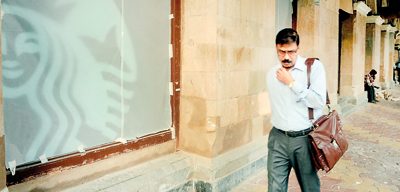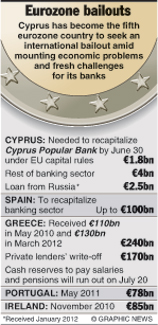Sunday Times 2
India’s feckless elite
Its political class may not be up to the task of leading India toward prosperity. Just the other day, it seemed as if India could hardly put a foot wrong. Annual economic growth averaged above eight percent between 2003 and ’08, and the country was one of the world’s few major economies to escape more or less unscathed from the global financial crisis.
In November 2010, President Barack Obama made the longest foreign visit of his presidency to India. There, in a rousing address to Parliament, Obama declared that “India has emerged,” and pledged to back New Delhi’s quest for a permanent seat on an expanded United Nations Security Council. By then, authors and analysts had already churned out a small rainforest worth of books and articles asserting that the 21st century belonged to Asia’s two giants, China and India.

A pedestrian walks past a window, covered with translucent material, of Starbucks' first Indian outlet undergoing fitting in Mumbai on October 17. (AFP)
Two years later, India’s rise looks a lot less certain. Economic growth slowed to an annual rate of 5.5 percent in the first quarter of the current fiscal year, and few independent analysts expected it to top six per cent in the rest of the year. For a country still at an early stage of development-in dollar terms, the average Indian earns about as much as the average Chinese did in 2004-this augurs ill. Most economists believe that India needs to grow by more than seven per cent annually merely to keep pace with the 13 million new entrants into the job market each year. (China’s growth rate, even after declining from its former torrid pace, is eight percent.) Pratap Bhanu Mehta, president of the Centre for Policy Research, in New Delhi, says India is “flirting with social catastrophe.”
Flagging growth isn’t the only cause for concern. Foreign direct investment plummeted 67 per cent in the first quarter of the current fiscal year, to $4.4 billion. The rupee has spent much of 2012 touching historic new lows. (By mid-September, it had lost 20 per cent against the dollar over the past 12 months.) Though arguably a one-off event, the massive power outage in July that left 600 million people without electricity dramatised the parlous state of Indian infrastructure to the world. The blackout was a powerful follow-up to a stark warning from ratings agency Standard and Poor’s the previous month-that India risked becoming the first “fallen angel” among the BRIC economies (Brazil, Russia, India, and China).
In September, the government raised the price of diesel fuel and announced a rash of long-awaited economic reforms in the retail, aviation, and power sectors. For the first time, big-box retailers such as Walmart will be allowed to own a majority stake in their Indian operations. But it remains to be seen if even these limited reforms, eight years in the making, will take hold amid a firestorm of protest by both the opposition and allies within the ruling coalition. As protestors take to the streets and coalition partners threaten to bring down the government, they highlight the unpredictability of Indian democracy and foreshadow a chaotic alternative to the smooth arc of progress assumed by many.
Meanwhile, Parliament has been paralysed by a series of high-profile corruption scandals. Violence between Muslims and indigenous people has flared in the northeastern state of Assam and between Muslims and Hindus in the Hindi heartland state of Uttar Pradesh. In August, some 50,000 migrants from the northeast who had come to western and southern cities such as Pune, Hyderabad, Bangalore, and Chennai in search of better lives abruptly fled homeward, fearing retaliation for anti-Muslim violence in Assam. In a panic, India’s government blocked more than 300 Web pages, only a handful of which would be considered inflammatory in most democracies. This action, along with a ham-handed attempt to shackle social media sites Twitter and Facebook, and the brief jailing of a political cartoonist under a colonial-era sedition law, casts doubt on the depth of the world’s largest democracy’s commitment to freedom of speech.
This catalogue of setbacks raises questions about the health of India’s polity. Are the country’s ruling elites up to the task of piloting a staggeringly diverse nation of 1.2 billion people, half of them under the age of 25, out of poverty and toward prosperity? Can economic reforms be pushed through in an era of dynastic politics, fragile coalitions, and powerful regional satraps? Can India’s institutions rein in resource grabbing of the sort once associated with post-communist Russia or Suharto’s crony-ridden Indonesia? Can politicians rise above appeals to caste, religion, and language and begin to debate the country’s future in terms of ideas? In short, will politics, in the broadest sense of the word, enable India to achieve its potential, or choke it?
To be sure, it’s far too early to write off India. It has confounded naysayers before. As far back as 1960, the journalist Selig Harrison famously predicted, in India: The Most Dangerous Decades, that the country would likely fragment or take an authoritarian turn. Except for a 21-month interregnum in the 1970s, when Indira Gandhi halted elections and suspended civil liberties, it did neither. Before India’s green revolution in the 1960s and ’70s, some doubted that the country would be able to feed its burgeoning population. It now grapples with the problem of surplus grain rotting in storehouses. And one year of slower growth hardly alters the broader fact that since the advent of economic reforms in 1991, things have been getting better faster than at any other time in Indian history.
In this period, India has pulled more than 200 million people out of poverty. According to the World Bank, the share of the population living below the poverty line has declined from more than half to less than a third.
Moreover, many elements of India’s relative success story since 1991 remain in place. The middle class, estimated to number between 60 and 300 million, depending on who’s counting, provides a vast consumer market. Unlike most developing countries, India is home to a clutch of ambitious companies with global reach. This year, 48 Indians made Forbes magazine’s list of the world’s billionaires. Mumbai-headquartered Tata Motors has defied sceptics and turned around the fortunes of Jaguar Land Rover after buying it four years ago. Anil Ambani’s Reliance ADA Group owns a 50 per cent stake in the Hollywood studio DreamWorks. In 2010, Mahindra and Mahindra took over South Korea’s Ssangyong Motor Company. India is also set apart from most developing countries by its deep domestic financial markets, which give business ready access to capital.
Although India’s savings rate has declined somewhat over the past three years, at 31 per cent it remains higher than it was in the 1990s and not much below the rates that powered the economic miracles of East Asia’s “tigers” in the 1970s and ’80s. And while company executives often gripe about education standards, only China churns out comparable numbers of engineers and management graduates each year. A large and prosperous diaspora-more than three million strong in the United States alone-acts as a bridge of ideas and innovation between India and the West.
As for India’s rickety democracy, on the positive side, a few relatively well-governed states such as Gujarat on the west coast and Tamil Nadu in the south have discovered the benefits of running business-friendly administrations. More competition among the country’s 28 states could lead to better governance over time. Last, but perhaps most important, for all its flaws, India’s democracy provides it with great structural stability. Unlike their counterparts in many countries at a comparable level of development, Indians can take the peaceful transfer of power by the ballot for granted at all levels of government.
Nonetheless, no country is immune to dysfunctional politics, and, looked at dispassionately, the odds aren’t exactly stacked in India’s favour.
As Brown University political scientist Ashutosh Varshney notes, “India is attempting a transformation few nations in modern history have successfully managed: liberalising the economy within an established democratic order.”
In other words, India embraced universal suffrage (at independence in 1947) at a much earlier stage of economic development than the most successful Asian economies-Japan, South Korea, and Taiwan. (Tiny Singapore can still be called quasi-authoritarian; the ruling People’s Action Party has held power continuously since independence in 1965.) Although India’s democratic experiment has worked remarkably well in many ways-not least by empowering those at the bottom of the social pyramid-the system also makes it extremely difficult to carry out important but unpopular reforms, such as slashing fertilizer subsidies and ensuring that farmers pay market rates for electricity.
Courtesy The Wilson Quarterly. For full version of this article, visit www.wilsonquarterly.com
Follow @timesonlinelk
comments powered by Disqus

























